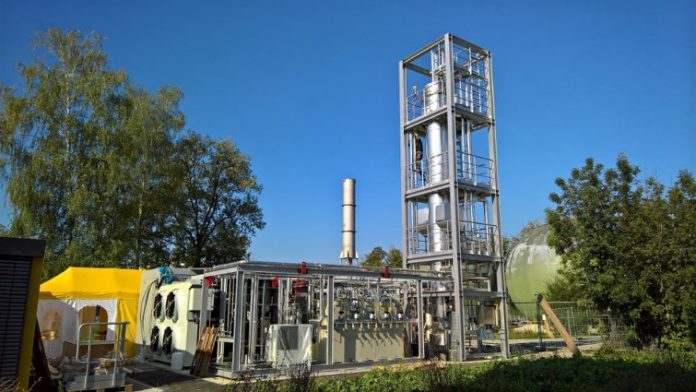The European research project STORE&GO at the finish line and about to publish a roadmap for the future integration of power-to-gas technology, writes Dr Frank Graf from the DVGW Research Centre at the Engler-Bunte-Institute of Karlsruhe Institute of Technology
The STORE&GO project is in the last months of its four-year duration. Three power-to-gas demo sites are in operation and produce first well-founded results. Cross-cutting activities deal with various technical and techno-economic analyses and regulatory recommendations for Europe. Results will be published over the coming months, culminating in a European power-to-gas roadmap. This will provide a strategy on how to integrate this promising technology into the continent’s energy system and how to contribute to the energy transition.
STORE&GO demo sites are in operation – another step towards a successful and renewable energy transition in Europe
The growing number of renewable power sources will demand long-term and large-scale storage in the future. One option is power-to-gas (PtG) that allows for storing power by producing synthetic hydrogen or methane. Generating gas from renewable electrical power with PtG is by far the most promising way to store large amounts of energy. It also reduces the need and cost of expanding the electricity grid.
To develop the technology further, three demonstration sites have been installed within the STORE&GO project. The first to operate was the power-to-gas plant in Falkenhagen, Germany. Its existing power-to-hydrogen process was expanded by a methanation stage in May 2018 and synthetic methane has been fed into the natural gas grid since January 2019. This allows the partners of the international research project STORE&GO to demonstrate the technical feasibility of the power-to-gas process for feeding “green” gas into the natural gas grid.
At present, the plant produces up to 1,400 cubic meters of synthetic methane (SNG) per day, which corresponds to approximately 14,500 kWh of energy. For comparison purposes, with this amount of energy, 200 golf class CNG cars could drive about 150 km per day. The plant has already achieved over 700 operational hours with a methane purity reliably above 99%. The green methane is produced from hydrogen which, in turn, is generated with electricity from renewable sources and CO2 from a bioethanol plant. The heat generated during the process is used by the nearby veneer mill, which increases the overall efficiency of the plant.
The second STORE&GO demonstration site is located in Solothurn, Switzerland (see Figure 1). It is the only one of the three STORE&GO plants that use biological methanation. Countless microorganisms, so-called Archaea, convert hydrogen and CO2 to methane in the central vessel. After many busy months working with high intensity to finish the plant, the operators could finally animate the frugal microorganisms to spawn and to generate methane. The Solothurn plant has been producing methane since May 2019.

The community of Troia in Italy houses the third of the STORE&GO demo sites. This plant combines direct CO2 capture from the air and a novel milli-structured methanation unit with an innovative micro-scale liquefaction unit for the produced methane. Such a sequence of new technologies displays possibly the most experimental one among the STORE&GO plants. The Troia process chain produced methane for the first time in April 2019. All three plants will use the remaining project duration to gather experience from the operation and to provide real data for further analysis within the project.
Analyses show: Power-to-gas increases energy security and lowers total costs of the energy system
The STORE&GO partners also performed a full cost-benefit analysis to assess the macro-economic value of having PtG in the year 2050. Results show that PtG lowers the total costs of the energy system and that it prevents more expensive investments or higher operational costs in other parts of the energy system. PtG increases the energy security of the energy system by lowering the probability of shortages of energy, for example, during periods of low wind and solar energy production in Europe. PtG could ease bottlenecks in the electricity grids and allow for including renewable energy at lower costs than what would be required for extending electricity grids.
From a technological point of view, renewable gases are ready to be integrated within the energy system. However, the current legal and regulatory framework and market conditions impede the installation of industrial-scale power-to-gas plants and the ramp-up of gas production. STORE&GO partners found out that an optimised plant layout combined with proper market conditions would enhance the viability and offer opportunities in particular for seasonal storage of renewable energy. For the future legislation period in Europe, it will be necessary to find a legal category for PtG, to define who is allowed to operate it and to harmonise rules for operating gas networks. The consortium will shortly publish all results mentioned herein deliverable documents on the project website and in peer-reviewed scientific publications.
Power-to-Gas roadmap
The STORE&GO project partners are working on channelling the results into a European PtG roadmap. The power-to-gas roadmap is being prepared and will be finished by the end of the project. All generated results and scenarios will be combined to set up a strategy for the integration of power-to-gas technology in Europe. The roadmap aims at a holistic approach considering a wide range of aspects such as techno-economic feasibility of energy storage operations, integration of PtG concepts in the electricity grid management and power supply, reduction of regulatory barriers for PtG, as well as potential market uptake for PtG across Europe.
On 3rd December 2019, STORE&GO will host a political dinner at the European Parliament, presenting the STORE&GO roadmap and other project results, with key stakeholders from politics, industry and the scientific community. The goal is to discuss all emerging topics regarding PtG and to showcase potential scenarios to implement PtG in Europe for the European energy transition.
Please note: This is a commercial profile
Dr Frank Graf
DVGW Research Centre at
Engler-Bunte-Institute of
Karlsruhe Institute of Technology (KIT)
Tel: +49 721 608 412 21











